In this interview, Dr. Heiko Haschke, Director BioAFM Business, Bruker Nano Surfaces and Metrology Division talks to AZoNano about the company, the products they list and the research they carry out.
Please can you introduce yourself and tell us about Bruker BioAFM?
After completing a PhD in Atomic Force Microscopy (AFM) instrumentation, I joined JPK Instruments AG, a pioneering firm in the field of BioAFM, which became part of Bruker in 2018. AFM is an advanced multiparametric imaging technique that delivers 3D profiles of sample surfaces in the nanometer range and enables the characterization of their nanomechanical properties. Scientists can use it to investigate morphology and surface structure at sub-molecular resolution and measure interactions in the piconewton range, making AFM an outstanding tool for the nanosciences.
Bruker BioAFM was one of the very first to recognize the potential of AFM in Life Science applications and has spearheaded its development for the investigation of complex biological samples, such as single molecules, nucleic acids, proteins, living cells and tissues. The ability of AFM to study samples in their native environment without damaging their structure is unique. Our latest product, the NanoWizard® V, the fifth generation of our principal AFM instrument, offers a degree of automation and comfort second to none. We expect it to make a profound impact on the field of biomedical sciences.
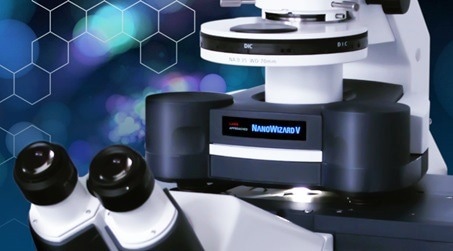
JPK NanoWizard® V BioAFM. Image Credit: Bruker BioAFM
How have the applications for technology like the NanoWizard® V developed over the last few years?
Until recently, the demand for automated, high-throughput analysis techniques limited the use of AFM in areas such as biomedicine and clinical environments. We are happy to say that the NanoWizard V has changed that! Recent developments in automated setup and experiment control, higher throughput and standardized analysis features have opened the technology to new areas, establishing AFM as a highly relevant tool in fields such as pharmaceutical research, nanomedicine, nanodiagnostics and drug-targeting.
Many pathological diseases, such as cancer, inflammation and neurological disorders, are closely associated with changes in the mechanical properties of cells. Metastatic cancer cells are approx. 70% less stiff than benign cells and lower stiffness correlates with higher invasiveness. These changes, which can be structural or compositional in nature, can ultimately be used as markers for the early detection of an underlying disease. AFM can, therefore, be used in the identification of disease-related structural changes on the basis of nanomechanical biomarkers that could hold the key to the early detection of neurodegenerative diseases, such as Parkinson's or Alzheimer's, and cardiovascular disease.
AFM can also play an important role in drug discovery and drug delivery. Particle size and the surface and structural properties of solid pharmaceutical forms significantly influence the bioavailability and efficacy of active ingredients. The ability of AFM to not only identify surface structure and properties, but also to quantify cell/surface and nanocarrier/membrane interactions as well as morphological changes occurring following contact of a drug candidate with a cell membrane, are expected to make a significant contribution in the search for novel drug targets and drug discovery.
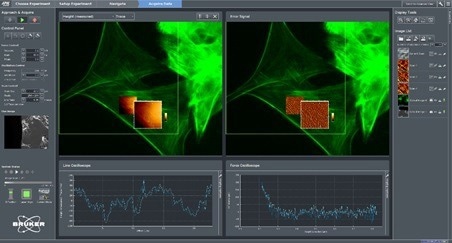
JPK NanoWizard® V BioAFM control software showing mechanical measurements on fluorescently labelled living cells. Image Credit: Bruker BioAFM
The market for nanostructured biomaterials and nano-architectures that can dramatically improve implant materials and enhance tissue regeneration is also considerable. As AFM enables the study of dynamic material properties in a controlled manner at the molecular level, it is expected to play a role in the development of applications such as responsive surfaces, smart materials, soft robotics and nanomedicine.
How have you stayed ahead of these changes?
At Bruker BioAFM, we are privileged to work together with top research groups worldwide. Their technical input is invaluable, and we strive to react quickly to their needs and, where possible, provide customized solutions for their work. In this way, we stay close to the pulse of the R&D community, can respond quickly to new scientific developments and maintain our position at the forefront of innovation. In doing so, we recognize new and interesting fields of science, such as mechanobiology, nanomedicine, and nanobiotechnology, as they emerge.
Each new development and generation of BioAFM systems has extended the capabilities of the technique and led to a wider range of applications in materials and life science research. We are proud to say that we have been at the forefront of these developments, continuously pushing the boundaries of science and making the AFM technology faster, easier, and more accessible for users in almost all fields of science.
The steady increase in the use of AFM and scientific publications in the field of health-related nanotechnology, mechanobiology, cell adhesion, and tissue engineering, confirms our approach.
Can you explain what the main functions of the NanoWizard® V are?
The Nanowizard® V marks a new benchmark in automation and delivers a host of new technical capabilities. The automated set-up, operation, and calibration make it easy even for non-experts to set up and run an experiment and obtain top-quality images and data quickly and easily. The increased throughput, standardized batch analysis routines and the generation of statistically relevant data-sets, essential tools in clinical research, are vital for nanomedical and therapeutic research.
The new PeakForce-QI™ mode delivers unique quantitative nanomechanical imaging capabilities and is ideal for investigating the structural and nanomechanical properties of delicate, soft and loosely bound biological samples at nanometer resolution in physiological conditions.
Other key features include the tip-scanning AFM design and a new fast scanning option with speeds of up to 400 lines/sec. The NanoWizard V has been specifically designed to provide automated, fast-scanning capabilities over a large scan area, thereby, increasing productivity. Advanced force control enables the nanomechanical characterization of single molecules, cells, tissues, and other highly delicate samples.
The ExperimentPlanner feature enables scientists to design complex experimental routines, and the remote-control feature allows them to oversee and adjust experiment parameters remotely. Together these features open a world of new possibilities for long-term, self-regulating experiment series that reflect “real-life” conditions, alleviating long and repetitive experiments and giving researchers the freedom to oversee and control their experiments remotely.
What does the JPK NanoWizard® V offer the consumer that competing systems cannot?
No other commercially available BioAFM platform offers the same combination of easy setup, intelligent, automatic operation and comprehensive force measurements as the NanoWizard V. Functions, such as the fully automated cantilever and detector alignment, optical image calibration and single-click cantilever calibration, make it easier to set up an experiment and faster to run.
Seamless integration with advanced optical imaging techniques, such as epifluorescence, confocal, TIRF, and super-resolution microscopy (STED), delivers real-time correlative data sets, making the NanoWizard V a powerful tool and especially useful in multi-user imaging facilities.
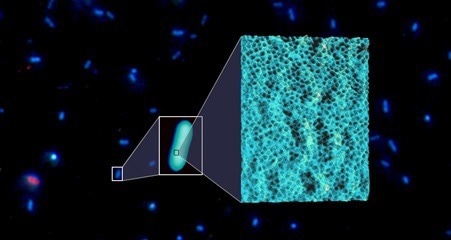
Background image: fluorescently labelled bacteria. Inset: single bacterium imaged with JPK NanoWizard® V BioAFM. High-resolution inset: PeakForce-QI topography image, longer side 250 nm, height range 3 nm. Image Credit: Bruker BioAFM
Fast scanning is vital for increased throughput and studying dynamics, but in other commercial systems it is generally limited to flat samples. Our NestedScanner feature enables fast scanning of challenging samples with large topography ranges and provides simultaneous control of two Z-piezo actuators: The smaller one for high-speed feedback control and the larger one for increased Z-motion control. Bidirectional scanning utilizes the full XY-cantilever motion without compromising image quality, and improved capacitive sensors deliver lowest noise in closed loop at the highest scan speeds.
Bruker BioAFM’s Vortis 2 controller can effortlessly process huge volumes of data with unparalleled data accuracy. The very high bandwidth enables accurate force control and fast feedback even with a large 100 μm scanner.
How does the JPK NanoWizard® V study biological processes in real-time?
In dynamic processes, there is a very short window of time in which to observe a reaction, particularly in harsh environments. Speed is the key to capturing short, very fast events and reactions that occur in milli-seconds.
Technological developments such as advanced piezo and sensor technologies, mechanics designed to minimize thermal drift and noise have all contributed to improved speed rates. The NanoWizard V has a frame rate of between 1 - 40 fps and can follow reactions across multiple time-scales, from milli-seconds for the molecular range (100 nm), to seconds and minutes.
Environmental control options enable the user to run temperature dependent experiments and observe effects, such as oxidative chemical reaction processes and phase transitions, in real time.
Atomic Force Microscopy - Annexin V P6 Honeycomb Lattice
Annexin centric trimer molecular dynamics. Video Credit: Bruker BioAFM
What are the benefits of advanced force control for the characterization of molecules, cells, tissues and other samples?
Forces play a crucial role in mechanisms such as molecular recognition and signaling, receptor-ligand binding kinetics and protein self-assembly and can be used to study interaction-based, disease-related changes. Nanomechanical information can be gathered by measurements generally known as force spectroscopy or force curves.
Techniques such as Single-Molecule Force Spectroscopy (SMFS) and Single-Cell Force Spectroscopy (SCFS) are now fully automated, providing highly sensitive force control and saving tips. The NanoWizard V provides minimized tip-sample interaction, enabling researchers to measure adhesive forces while keeping even fragile samples intact. Advanced features, such as force-clamp, force-ramp and the RampDesigner™ feature enable advanced force curve designs and comprehensive fitting routines. The fast Z-scanner with capacitive sensors delivers reliable force curves even at high speeds.
The PeakForce-QI mode uses minimal interaction forces and provides excellent control of surface tracking and probe-sample interactions. This enables easy imaging of samples, even for non-experts or occasional users. Its linear motion is ideal for quantitative force curve analysis and the full bandwidth data transfer (1MHz) ensures that each and every curve is captured - including multiple taps per image pixel - and can be saved for analysis. Different movement patterns can be chosen depending on the application and required speed.
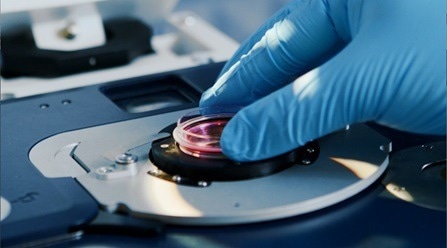
PetriDish Heater sample holder. Image Credit: Bruker BioAFM
What challenges do NanoWizard® V users face in the lab, and how will this device help them? Can users operate it without training?
Bruker BioAFMs in general are designed with ease-of-use in mind, with a structured workflow, intuitive user guidance and advanced data processing routines. They meet the growing demand for correlative technologies that can be comfortably operated by biologists, chemists and physicists alike and not only by highly specialized personnel. Our AFM platform is ideal for multi-user facilities where the needs of beginners and experienced users differ widely. Advanced features can be “unlocked” and the range of experiments and options adapted to the level of experience of the users.
Biological samples can be difficult to obtain and assay materials are expensive. A key advantage of AFM is the small amount of sample needed to perform such studies.
Working with Biohazardous materials, in particular in the wake of the recent global pandemic, is vitally important but very challenging. The Nanowizard V enables direct access to pathogens and infectious agents in biosafety laboratories, so that sample preparation, loading, disposal and experiments can be performed directly in the biosafety facility.
Smart mechanical sample analysis and adaptive intelligent scanning routines and optical integration deliver reliable correlative measurements or optically guided AFM.
The MultiScan feature enables fully automated tissue diagnostics with automated large area multiparametric characterization of densely packed cell layers and highly corrugated tissue samples.
Where can readers find more information?
www.bruker.com/bioafm
About Heiko Haschke
After completing a PhD in Atomic Force Microscopy (AFM) instrumentation, Dr Heiko Haschke joined JPK Instruments AG, where he lead the applications group and managed customer services. Since becoming part of Bruker in 2018, his role was extended to strategic development and other areas of the business. He is now Director of the BioAFM Business within Bruker Corp.
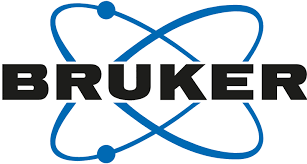
This information has been sourced, reviewed and adapted from materials provided by Bruker BioAFM.
For more information on this source, please visit Bruker BioAFM.
Disclaimer: The views expressed here are those of the interviewee and do not necessarily represent the views of AZoM.com Limited (T/A) AZoNetwork, the owner and operator of this website. This disclaimer forms part of the Terms and Conditions of use of this website.